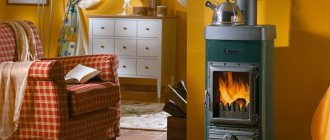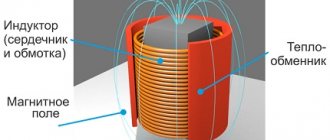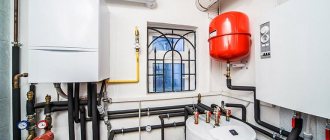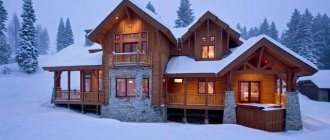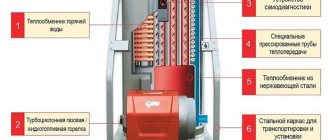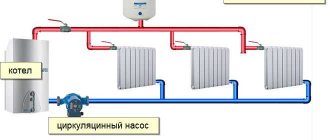Design and principle of operation
On the modern market you can find a huge number of models of solid fuel boilers, but their design and operating principle are not much different. Any equipment for heating rooms consists of the following parts:
- fuel combustion chamber;
- chimney;
- ash collection chamber;
- coil or heat exchanger.
The simplest models of solid fuel boilers are somewhat reminiscent of a potbelly stove. After the wood burns, the flame heats the pipes with water, the liquid is heated and enters the double-circuit heating system. The efficiency of the models is low, and fuel consumption is significant.
Modern units have an improved design; they are equipped with automation that regulates the combustion process. After fuel combustion, heated water is supplied by a circulation pump to the radiators. Heating devices give off part of the heat, the liquid is cooled and flows through the return pipeline into the boiler. Modern heating systems are often equipped with a closed expansion tank, which avoids water evaporation during heating.
During the combustion of wood, smoke is generated, which is discharged to the street using a chimney. After some time, soot settles on the walls of this structure, which leads to a decrease in the diameter of the pipe and a deterioration in traction. To clean the chimney from dirt, special openings with dampers are used. Soot is removed from the canal using special brushes or brushes.
Note! To clean the chimney from soot, you can use special solutions that are added to the fuel. They allow the inner walls of the pipe to be cleaned during the combustion process.
Automation helps increase the efficiency of a solid fuel boiler:
- the temperature sensor is triggered when the coolant temperature drops, it sends a signal to the control panel to turn on the fan;
- the pressure gauge gives a signal when the pressure increases above normal levels;
- to prevent emergency situations, a bleed valve is installed in the system;
- the circulation pump begins to pump water after heating the coolant in the boiler to certain temperature parameters.
The efficiency of the boiler depends on the type of fuel used. If the unit is designed to operate on wood, then coal or pellets cannot be used. It is also not recommended to use insufficiently dried firewood; they provide little heat, but produce a lot of soot and water vapor.
Main and additional boiler
When installing a backup (emergency) boiler, it is recommended to increase the area of the boiler room by 4 m². An additional heater helps maintain the temperature of the coolant, avoiding accidents when the main unit breaks down or when the fuel runs out. Design options:
- Electric. Installed separately or in the form of combined models - heating elements are built into the solid or liquid fuel boiler, which automatically turn on when the coolant cools;
- Solid fuel or liquid fuel. They can complement a gas boiler or work “in pairs” - the liquid fuel heater starts when coal or firewood runs out;
- LPG. Many people leave the gas holder after connecting the main gas - liquid fuel is stored in the gas holder for years and is used as needed. Its own capacity ensures that the house will not be left without heat in the event of a gas pipeline accident.
The additional boiler is installed in a finished boiler room or separately. If main gas is used as the main energy carrier, then when installing additional equipment in the same room, you must rely on the requirements of SP 62.13330.2011.
It is possible to combine heating equipment into a “smart home”, connect to remote control, and automatically adjust the temperature taking into account the readings of weather-sensitive external sensors.
Advantages and disadvantages
Before installing a solid fuel boiler in a wooden house with your own hands, you need to familiarize yourself with the strengths and weaknesses of the unit.
The main advantages of the equipment in question include:
- Heating operation when the power is turned off - just open a special tap and let the coolant flow directly.
- Affordable, almost free fuel, especially for people who live near forested areas.
- Easy installation of a wall-mounted boiler in a wooden house.
- Low price of equipment.
In addition to the advantages, the scheme with a solid fuel wood boiler has several disadvantages:
- significant mass of the unit, because cast iron is used for its manufacture;
- a person must constantly monitor the boiler and adjust its operation as necessary, for example when the power is turned off;
- increased fuel consumption, soft wood produces little heat when burned;
- low efficiency, maximum 80%;
- large dimensions of the unit.
Many owners install a wall-mounted gas boiler in a wooden house, but this is only possible in the immediate vicinity of the gas main. Most owners of private country houses use a solid fuel wood boiler to heat their homes. Its installation has its own nuances.
Boiler selection
First of all, the boiler is selected according to the type of fuel used. It should be the most accessible. If the suburban area is remote from the gas main, then solid fuel or diesel boilers would be a good alternative. As a last resort, electric models can be considered. Such heat sources are subject to less stringent requirements, however, they are very expensive to operate.
Next, the boiler is selected based on power. It is indicated by the manufacturer in kilowatts. The power is calculated depending on the total area of the heated premises, as well as on how the wooden house is insulated, what thickness of timber it is built from, and so on. If the log house was built taking into account permanent all-season living, and all the main features of a particular technology were taken into account, then for every 10 m2 of such wood, 1 kW of thermal power will be required.
Example. There is a house made of profiled timber with a cross-section of 140 mm (the floors and floors are normally insulated) with an area of 80 m2. To heat it, you will need a boiler (regardless of fuel) with a power of 8 kW. It should be noted that in practice this value turns out to be too small or close. And if we take into account that wooden houses do not always have walls of a sufficient cross-section (in order to save money), then the power obtained in this way will not justify itself at all.
If there is gas
A full-fledged gas boiler room is being designed in a private house without installing temporary heating systems. The project takes into account the location of the main line, the laying of the gas pipeline, and the entry point into the building.
Equipment set: boilers (gas electric), expansion tanks, boiler
Before connecting the main line, you will need to develop a gasification project, carry out technical specifications, install equipment for the gas boiler room at home, and lay a gas pipeline on the site. The main thing when building houses from timber with a boiler room is to take into account the requirements for the premises in the design, so that you do not have to cut a window, move equipment or make an extension.
If the village is planned to be connected to the main line in the next 2-3 years, then it is better to immediately prepare the premises for the use of gas. For heating, a model running on electricity or liquefied gas is temporarily used. After connecting the gas pipeline, the equipment is dismantled, configured for natural gas or becomes a backup heating circuit.
Efficient use of boiler room space
During installation, it is sufficient to comply with the requirements of the equipment operating instructions. The owner has 4 options for choosing a boiler for a private home:
- Using solid fuel (firewood, coal, pellets, sawdust briquettes);
- Liquid fuel (diesel, waste oil, fuel oil);
- On liquefied gas (LPG);
- Electrical.
No permits are required for installation and use; the boiler can be placed anywhere without approval. Compliance with safety rules falls on the shoulders of the owners.
The first stage of installing a boiler room in a wooden house is choosing a room. There are several types of boiler rooms based on their location:
- Boiler room in a separate room. This location is considered the most preferable, both in terms of the convenience of the owners and in terms of compliance with standards and rules. The boiler and pump are sources of constant noise; an autonomous location solves this problem. On the other hand, the Rules for the placement of boiler installations impose certain requirements on boiler room premises, which are easier to implement in a separate building. The power of a boiler installed in a separate room can be more than 200 kW.
- Boiler room in the extension. The advantage is the possibility of building a room close to the house, saving on communications. The system power requirements are similar to the conditions for free-standing boiler houses.
- Boiler room in the house. As a rule, boiler rooms are installed in the basement or on the first floor, next to the bathroom, pantry, garage and other utility rooms. If you are looking for a project with a boiler room located inside the house, we will be happy to offer you standard projects No. 18, No. 21, No. 36. These and other options are also possible with the organization of boiler rooms in a separate room or an extension. When installing a boiler room in a wooden house, special attention must be paid to fire safety. Also, you will have to take care of soundproofing the boiler room. According to the rules, boiler systems with a power of no more than 30 kW can be placed in the kitchen, and in separate rooms - from 30 to 200 kW.
Installation
Installing the boiler on a wooden floor is possible with your own hands without the help of a specialist. To carry out work there is no need to obtain special permission from the relevant authorities. It is necessary to prepare a special, well-ventilated combustion chamber. It is equipped in accordance with fire safety requirements.
Important! Building regulations from 2000 state that a separate room is required for a heating unit with a power of 60 kW or more. Boilers of lower power can be installed in a kitchen with a room volume of at least 15 m3 and a ceiling height of 2.5 m.
There are a number of requirements regarding the firebox design:
- it is necessary to install a window in the room for ventilation;
- installation of utilities (ventilation, water supply system, sewerage).
The glazing area depends on the volume of the room: at least 0.03 m2 for every 1 m3 of furnace volume.
Foundation
Particular attention should be paid to the foundation for a boiler in a log house. When installing a floor-standing unit with a power of up to 50 kW, you can use a cement-sand screed as a base, but when installing more powerful units this will not be enough. You will need a separate concrete foundation, which will protrude 25–30 cm from the dimensions of the boiler installation.
When installing the unit, certain requirements regarding the floor material are imposed. The equipment must not be installed on a flammable wooden base. If it is not possible to pour a concrete foundation, then the boiler in a log house is installed on a podium made of refractory brick, sheet metal or asbestos. The base should protrude from the dimensions of the boiler by at least 15 cm on each side and 20 cm in the firebox part.
Ventilation
The correct supply ventilation system can increase the efficiency of the boiler installation and ensure the required level of fuel combustion. Utility parameters are calculated based on the size of the furnace and the power of the installed equipment.
For normal operation of a small boiler with a power of up to 35 kW, it is enough to punch a small hole with a cross-section of 30 × 30 cm on the wall opposite the boiler in the lower level to provide fresh air flows. An exhaust vent with a cross-section of 40 × 40 cm is also equipped at a distance of 30 cm from the ceiling level in the opposite part of the room.
Note! The need for a supply and exhaust ventilation system arises through the vacuum that occurs as a result of fuel combustion. It is compensated by the influx of fresh air, and the hood is used to remove exhaust gases outside the house.
Chimney
Any heating equipment in which fuel is burned must be equipped with a chimney. The location of this channel is indicated at the design stage of the building. If the chimney is not provided for in the design documentation, it is made independently from brick or special material.
A modern version of the chimney are insulated sandwich modules, which are made of stainless steel and insulation (mineral wool). The exhaust gas removal shaft is assembled from parts of the required diameter. The standard height of the components is 1 m. There are certain requirements for the chimney of a solid fuel boiler:
- constant cross-section along the entire length of the pipe;
- shaft diameter for household models is within 15–20 cm;
- no tilts or bends;
- It is prohibited to join sandwich modules within the floor slab.
If necessary, you can move the chimney, but no more than 1 m from the standard position. To prevent the possibility of fire in roofing materials or other building structures, chimneys are equipped with spark arresters.
Connecting the unit to the heating system
After installing the boiler, preparing the ventilation system and installing the chimney, they begin piping the heating unit. One important rule must be observed: under no circumstances should cold water come into contact with the heat exchanger of a running installation. Due to the temperature difference, condensation forms on the walls of the combustion chamber, on which soot settles and turns into viscous stable accumulations. Sticky deposits are difficult to clean off and reduce the efficiency of installed equipment.
Standard piping with a three-way valve and bypass helps reduce condensation. The circuit is adjusted to the coolant temperature in the range of +50–55 °C. As a result of heating, the water moves along the circuit of the heating system until it warms up to the specified parameters. After this, the three-way valve is turned on, which mixes the cooled liquid from the return of the heating system.
When piping a solid fuel boiler, it is necessary to proceed from the manufacturer’s requirements, which are set out in the instructions for the specific model of the unit. It is important to correctly connect the burner to the control unit. European models of heating equipment often have a fire protection system. The mechanism is connected to the central water supply.
Wood boiler installation instructions
Regardless of what type of TT boiler you bought - direct combustion, pyrolysis or pellet, the installation procedure remains the same and consists of the following steps:
- Selecting a specific location in a private house for placing a heat generator.
- Preparing the premises for installation.
- Supply and exhaust ventilation device.
- Installation of heating unit and chimney.
- Connection to the heating system (piping) and test run.
An ideal boiler room from our expert Vladimir Sukhorukov. Heavy equipment stands directly on the concrete floor
Note. Depending on the model of a wood-burning or coal-fired boiler, it may be necessary to connect to the electrical network.
The first 3 items on the list relate to preparatory work, which does not at all detract from their importance. If you choose the location of the unit incorrectly and do not provide for normal ventilation, then you will have to solve the problems that arise during operation, in the middle of the heating season. So we suggest looking at each point separately.
To correctly select a heat source based on power, we recommend calculating the heating load using a suitable method.
Where is the best place to install a TT boiler?
It is noteworthy that to this day no country of the former USSR has developed a specific regulatory document regulating the installation of solid fuel boilers in private and apartment buildings. The main part of the requirements is set out in SNiP “Heating and Ventilation”, certain standards are found in the document SNiP 31–02-2001 “Single-apartment buildings” (for Russia) and in other scattered acts.
An example of installing a pyrolysis heat generator with convenient access to the expansion tank and chimney
Reference. Many online resources send us to read the huge SNiP “Boiler Installations”, without taking into account that its effect extends to heat generators with a capacity of over 360 kW (clause 1.2). Others suggest that we follow the rules for gas heaters. Both options are wrong: the requirements for the placement of domestic TT boilers are not so stringent.
We analyzed the regulatory documentation regarding the placement of wood-burning hot water heaters, added to them the practical experience of our experts and compiled a list of recommendations for the location of the unit:
- The use of firewood, coal and even briquettes with pellets involves increased dust, and during the combustion process smoke enters the room in different quantities. Therefore, it is extremely undesirable to install a boiler in the house, although the norms allow placement in the kitchen, hallway and other rooms except bedrooms.
- The best places for a solid fuel heat generator: a boiler room on the street (separate or attached to an existing building), a technical room inside the house, a basement or garage. The last option is a well-ventilated corridor.
A good solution is to attach a solid fuel boiler room made of foam blocks to the wall of a residential building - It is advisable to install the unit closer to the external wall, so as not to lay a long horizontal section of the chimney or bring it out through the ceilings.
- To maintain and clean the heat exchanger of a TT boiler, ensure access to it from the right sides. Ideally, there should be at least 1 m of free space in front, and 60 cm on the sides and back (minimum 25 cm).
Installation diagram with permissible distances to the walls and ceiling of the boiler room - Do not expect to connect the flue duct of a wood-burning heater to brick ventilation ducts inside the walls, this is strictly prohibited.
Advice. Before purchasing and installing a long-burning boiler of the Stropuva type, compare its height with the premises. Consider the location of other large equipment - a heat accumulator, a buffer tank and an indirect heating boiler.
When there is not enough space in the furnace room, the boiler is installed closer to the wall to provide passage.
In small furnace rooms, move the boiler with the unattended side to one of the walls (minimum distance - 10 cm), and leave an opening at the back with a width of at least 250 mm, as shown in the photo .
About preparing the premises
What needs to be done before installing a TT boiler in the intended room of the house:
- provide a foundation and, if necessary, cast a concrete foundation;
- punch holes in the wall for the chimney and ventilation;
- walls and floors built from flammable materials should be protected from fire with sheets of metal, asbestos cement, basalt cardboard or mineralite.
Recommendation. If only lighting is provided in the furnace room, then connect an electrical line from the electrical outlet there. You will still have to power the circulation pump, or even the automation of the new heat generator.
An example of protecting wooden partitions and the floor next to a wood-burning boiler.
It is not necessary to tear off the wooden lining of the walls and floor. If the boiler is moved closer to a combustible wall than 38 cm, cover the latter with one of the materials listed above. Place the same sheet on the floor below and in front of the TT boiler with a protrusion of 80 cm. This is protection against heat particles flying out of the open door.
Regarding the foundation required by all manufacturers in the operating instructions, we will give the following recommendations:
- Low-power heaters weighing up to 200 kg can be safely placed on a cement screed. If it is designed correctly, it will withstand such a load without any problems.
The Atmos 90 kW pyrolysis boiler with a cast iron heat exchanger must be placed on a reinforced concrete base - Installation of a solid fuel boiler weighing up to 300 kg will require a reinforced concrete screed 10-12 cm thick, and over 300 kg - a separate foundation slab.
- Pellet heat generators equipped with a feed auger and an electric motor exert a vibration load on the base. This means that the foundation shown in the diagram needs to be cast.
Recommendations for effective operation
During operation of a wood-burning boiler, slag accumulates in the furnace of the installation. As they accumulate, such combustion waste must be removed, because it reduces the efficiency of the unit. A decrease in efficiency by 3% is possible with the formation of a slag deposit 1 mm thick.
It is necessary to clean the walls of the boiler combustion chamber at least once a week. At the same time, the wheel gratings are cleaned. To get rid of ash and other accumulations, just move a special lever and dump the coals into the ash pan.
The installation of a circulation pump allows you to increase the energy efficiency of your heating system. The device will move water through the system faster, the liquid returns to the boiler at an increased temperature. This means that it will take less time to warm it up again. The circulation pump is usually located in the return pipe before entering the boiler.
When servicing a heating unit, it is necessary to periodically check the draft in the chimney. The channel is cleaned from soot at least once a year. To prevent the formation of condensation, special sandwich pipes are used to construct the chimney or sections of the duct located outside the room are insulated.
